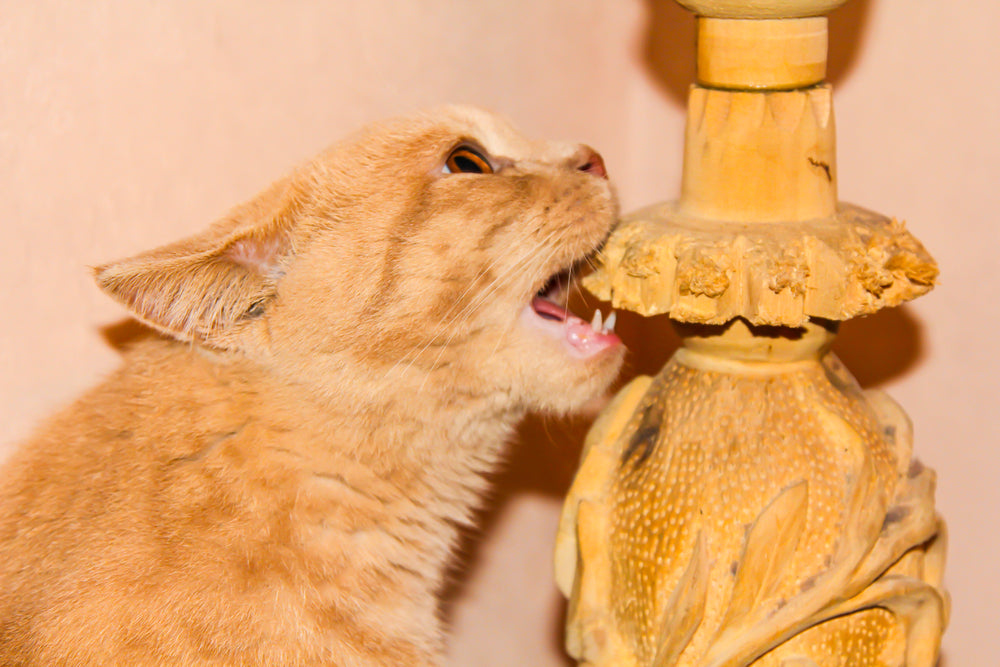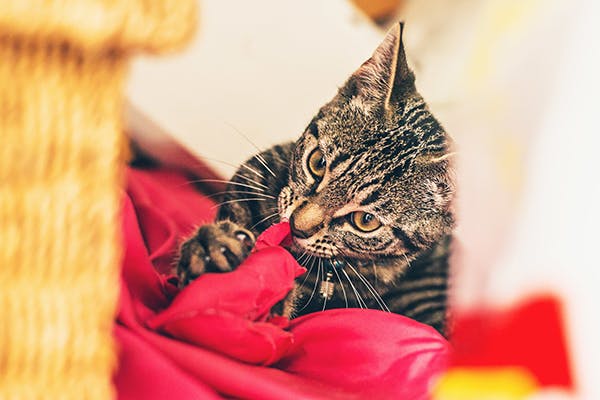Pica in cats can be caused by toxicity from certain substances. Pica in cats, which is the consumption of non-food items, can sometimes be triggered by exposure to toxic substances.
Cats are known for their curious nature and may inadvertently ingest toxic materials such as chemicals, plants, or medications. These toxic substances can disrupt the normal functioning of the cat’s digestive system, leading to unusual cravings and the development of pica.
Understanding the specific toxins that can cause pica in cats is crucial for pet owners and veterinarians in order to prevent potential harm to feline companions. We will explore some common toxic substances that can induce pica in cats, as well as the signs, symptoms, and preventive measures to ensure the health and well-being of our furry friends.
Understanding Pica In Cats
Pica in cats can be caused by toxicity from various sources. Understanding what toxic substances can trigger this behavior is essential for cat owners to ensure their furry friends are kept safe and healthy.
Definition And Symptoms Of Pica In Cats
Pica in cats refers to the irresistible urge to consume non-food items. This condition is often a sign of an underlying issue, such as nutritional deficiencies, behavioral problems, or gastrointestinal disorders. Identifying the symptoms of pica in cats can help in determining the appropriate course of action to prevent potential harm to our feline friends. Possible symptoms include eating non-food substances such as plastic, wool, rubber bands, or plants. Excessive vomiting, diarrhea, and weight loss are common signs as well. Additionally, owners may notice changes in the litter box behavior, with cats urinating or defecating outside of their usual area. To address pica in cats, it is essential to consult a veterinarian and conduct a thorough examination to identify the causal factors and develop a tailored treatment plan.
Common Household Toxic Substances
Living in a household filled with potential toxic substances can pose a significant risk to cats. It is crucial to be aware of these common household toxic substances in order to protect our feline companions. Some of the most frequently encountered toxic substances include:
| Toxic Substance | Potential Dangers for Cats | Toxicity Level |
|---|---|---|
| Household cleaning products | Can cause gastrointestinal upset, respiratory distress, and even chemical burns if ingested or exposed to a cat’s sensitive skin. | Varies depending on the specific product and its ingredients. |
| Human medications | Several over-the-counter and prescription medications can be toxic to cats, leading to serious health issues or even fatalities. | Varies depending on the medication and dosage. |
| Plants | Some common household plants, such as lilies, poinsettias, and philodendrons, are toxic to cats and can cause severe health problems if ingested. | Varies depending on the plant species and the cat’s sensitivity. |
Note: It is important to remember that the toxicity level of each substance can vary depending on the specific product and the amount ingested or exposed to. Being cautious and keeping these substances out of reach of our feline friends is crucial for their well-being.
Harmful Effects Of Consuming Toxic Substances
Toxic substances can have harmful effects on a cat’s health if ingested. Short-term consequences may include gastrointestinal upset, such as vomiting and diarrhea. Additionally, the cat may experience lethargy, loss of appetite, and difficulty breathing. In some cases, seizures or neurological symptoms may also occur.
However, the long-term effects of consuming toxic substances can be even more serious. Prolonged exposure to certain toxins can lead to organ damage, such as liver or kidney failure. Toxicity can also weaken the immune system, making the cat more susceptible to infections and diseases. Ingestion of certain substances, such as certain plants or chemicals, can even be fatal for cats.
Therefore, it is important to ensure that cats are kept in an environment free from toxic substances. This includes keeping poisonous plants out of reach, storing chemicals securely, and being aware of potential hazards in the surroundings. In cases where poisoning occurs, it is crucial to seek immediate veterinary attention to minimize the potential damage and provide appropriate treatment.
Chemicals Found In Cleaning Products
Chemicals Found in Cleaning ProductsPets, including cats, can be at risk when they come into contact with toxic chemicals commonly found in cleaning products. Cats are particularly vulnerable to the effects of these chemicals due to their grooming habits. Some of the most concerning chemicals include:
- Phthalates: Found in air fresheners and fragrances, phthalates have been linked to reproductive issues and hormonal imbalances in cats.
- Ammonia: Present in window cleaners and some floor cleaning products, ammonia can irritate a cat’s respiratory system and cause difficulty breathing.
- Perchloroethylene: Often used in dry cleaning solutions, this chemical can be toxic if ingested or inhaled and may lead to liver damage in cats.
It is important to keep these products out of your cat’s reach and use pet-safe alternatives whenever possible. If you suspect your cat has come into contact with a toxic chemical, it is recommended to seek immediate veterinary care.
Poisonous Indoor Plants And Flowers
Indoor plants and flowers can add beauty and freshness to our homes, but some of them can be toxic to our feline friends. It is important to be aware of the common indoor plants that are toxic to cats to keep them safe.
| Common toxic indoor plants: | Symptoms and risks: |
|---|---|
| Lilies | Severe kidney damage, vomiting, lethargy |
| Pothos | Irritation, burning sensation, difficulty swallowing |
| Dieffenbachia | Swelling, difficulty breathing, oral irritation |
| Peace lilies | Mouth irritation, vomiting, difficulty swallowing |
These are just a few examples of toxic indoor plants. If your cat ingests any part of these plants, it is essential to seek veterinary care immediately. The symptoms mentioned above can indicate serious toxicity. Additionally, it’s crucial to keep all potentially toxic plants out of your cat’s reach to prevent accidental ingestion and ensure their well-being. Educating yourself about the different plants that can be harmful and taking appropriate precautions can go a long way in keeping your cat safe and healthy.
Human Food Hazards
There are several human foods that can be toxic to cats if ingested. These foods should be kept away from cats to prevent any potential health risks:
| Food | Symptoms | Risks |
|---|---|---|
| Chocolate | Vomiting, diarrhea, rapid breathing, increased heart rate | Potential organ damage, seizures, and even death |
| Grapes and raisins | Vomiting, diarrhea, abdominal pain, decreased appetite | Potential kidney failure |
| Onions and garlic | Weakness, vomiting, pale gums, increased heart and respiratory rate | Potential damage to red blood cells |
| Raw eggs, meat, and fish | Vomiting, diarrhea, salmonella or E. coli infection | Potential food poisoning |
It is important to note that these are just a few examples of toxic foods for cats. Cats have a sensitive digestive system, and certain human foods can cause serious health issues. It is best to consult with a veterinarian regarding a cat’s diet and avoid sharing human food with them. If you suspect that your cat may have ingested something toxic, seek immediate veterinary care.
Medications And Supplements
Common medications and supplements can be toxic to cats and may contribute to the development of pica. It is vital to store these substances properly and take necessary precautions to prevent accidental ingestion.
Some examples of medications that can be toxic to cats include:
- Nonsteroidal anti-inflammatory drugs (NSAIDs) like ibuprofen and aspirin
- Antidepressants such as selective serotonin reuptake inhibitors (SSRIs)
- Blood pressure medications like beta-blockers and calcium channel blockers
- Acetaminophen (found in some pain medications and cold remedies)
- Antihistamines including diphenhydramine
- Topical medications containing ingredients harmful to cats
It is also important to be aware of supplements that can be toxic to cats, including:
- Vitamins and minerals in excessive amounts
- Herbal supplements and remedies
- Weight loss products containing stimulants
- Joint supplements containing glucosamine or chondroitin
Always keep these medications and supplements securely stored in a cabinet or locked container to prevent accidental access by your cat. If you suspect your cat has ingested any potentially toxic substances, contact your veterinarian immediately.

Credit: www.dutch.com
Harmful Substances In Outdoor Environments
Exposing cats to certain outdoor hazards can lead to pica, a condition where they ingest non-food items. Cats are vulnerable to pesticides, fertilizers, and other toxic substances commonly found outdoors. Pesticides used in gardens or on lawns can contain chemicals that are toxic to cats. Fertilizers which may have hazardous ingredients like insecticides or herbicides can pose a threat if ingested by the feline friends. Other outdoor dangers include contact with paint chips or debris containing lead, as well as exposure to petroleum products like gasoline or motor oil that may be present in garages or driveways.
Cats that roam outside may explore areas where these substances are present, increasing their risk of exposure. It’s crucial to be aware of these potential dangers to ensure the safety and well-being of our feline companions. Understanding the hazards associated with outdoor environments helps us take appropriate precautions and prevent toxicity-related pica in cats.
Preventive Measures And Safety Tips
Educating cat owners on the importance of keeping toxic substances out of reach is crucial in preventing pica in cats. Cats are curious creatures, and the ingestion of inappropriate substances can lead to serious health issues. It is essential to carefully store household chemicals, medications, and plants that may be harmful to cats in secure cabinets or on elevated surfaces. This ensures that they are inaccessible to cats. Childproof latches can be used to secure cabinets.
Additionally, it is important to keep small objects such as buttons, coins, and string out of your cat’s reach, as these can be ingested and cause intestinal obstructions or other complications.
Furthermore, regularly inspecting your cat’s environment for potential hazards is crucial. Check for loose wires, exposed cords, or toxic houseplants that could be tempting to your feline companion. Replacing toxic houseplants with pet-safe alternatives can help minimize the risk of ingestion.
By taking these preventive measures and creating a safe environment for your cat, you can greatly reduce the chances of pica and keep your feline friend healthy and happy.
When To Seek Veterinary Assistance
- Lethargy
- Vomiting
- Diarrhea
- Loss of appetite
- Difficulty breathing
- Tremors or seizures
- Excessive drooling
- Uncoordinated movements
- Changes in urination
It is crucial to seek veterinary assistance if your cat displays any signs of toxicity. Cats are curious creatures, and they may ingest toxic substances unknowingly. If your cat exhibits symptoms such as lethargy, vomiting, diarrhea, loss of appetite, difficulty breathing, tremors or seizures, excessive drooling, uncoordinated movements, or changes in urination, it is essential to act promptly. Contacting a veterinarian can help determine the underlying cause of these symptoms and provide the appropriate treatment. Remember, timely intervention can be the difference between a full recovery and serious health complications for your cat.
Conclusion
Toxicity is a major cause of pica in cats, leading them to ingest non-food items. Household chemicals, plants, medications, and certain foods can all be toxic to cats, triggering this abnormal behavior. It is crucial for cat owners to identify potential sources of toxicity in their homes and take necessary precautions to prevent pica.
Regular veterinary check-ups and a safe environment will ensure the well-being and health of our feline companions.


